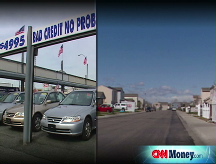Mortgage rates headed to 7%
The rate on a 30-year fixed mortgage has spiked recently, and it may climb higher thanks to the government's massive rescue efforts.
| 30 yr fixed | 3.80% |
| 15 yr fixed | 3.20% |
| 5/1 ARM | 3.84% |
| 30 yr refi | 3.82% |
| 15 yr refi | 3.20% |
NEW YORK (CNNMoney.com) -- Low mortgage rates, the one bright spot in a devastated housing market, are on the rise.
And while rates remain low by historical comparison, experts say they could continue to creep up.
The average interest rate on a 30-year, fixed rate mortgage jumped to 6.6% late Tuesday from 6.06% the Tuesday before, according to Keith Gumbinger of HSH Associates, a publisher of mortgage information.
A borrower with a $200,000 mortgage would pay about $1,207 a month at 6.06%, and $70 more at 6.6%.
Mike Larson, an analyst with Weiss Research who participates in Bankrate.com's weekly mortgage rate surveys, expects to see rates top 7% in the next six months, and then turn back down.
That's quite a bit higher than rates have been, but it's no disaster.
Gumbinger blames the rate increase on the massive federal bailout. To fund the rescue and the new government guarantees, Treasury must sell a raft of new Treasury bills to raise money.
"Who even has the cash to buy them all?" said Gumbinger. "The Treasury has to offer higher interest rates to sell."
Mortgage rates tend to move in conjunction with Treasurys.
But mortgage rates are higher than Treasury yields, because when mortgages are securitized and sold to investors, they're a riskier proposition than government bonds.
"There's any number of risks with mortgage securities," said Gumbinger, "including the risk that borrowers may not pay the mortgages at all."
So, with Treasury yields on the rise, mortgage rates should continue to be a more expensive for the next few months, he said.
There may be another factor at work sending rates skyward, according to FTN Financial Group analyst, Jim Vogel.
The cost of financing mortgages will grow for the biggest buyers of mortgage debt, Freddie Mac (FRE, Fortune 500) and Fannie Mae (FNM, Fortune 500), thanks to the plan for the Federal Deposit Insurance Corp. to back the newly issued, unsecured debt of some banks.
By guaranteeing bank debt, the government is making that debt more attractive for investors, and consequently creating more competition for Fannie and Freddie when they look to sell their own securities. To compete for buyers, the mortgage giants will have to raise their own yields - and to pay for that they'll have to charge borrowers higher interest.
"In theory, I think that could be correct," said Mark Zandi, chief economist for Moody's Economy.com, who is also an adviser to John McCain's presidential campaign. "But in practice, whether it means that rates will rise is an open question. There's a strong demand for really safe assets these days and Fannie and Freddie bonds are just a step removed from Treasurys."
If there's enough demand for ultra-safe investments like Fannie and Freddie bonds, Zandi says, they may not have to boost their yields all that much to attract investors.
Zandi pointed out that the difference between Treasury yields and 30-year mortgage rates is very high right now, more than 2% compared with 1.5% normally. That's because investors fled to risk-free Treasurys when the markets panicked.
But eventually, he says, the government rescue may send mortgage rates down and narrow that spread. "If that helps bring down the general angst, than mortgage rates should fall," he said.
Gumbinger expects rates to stay higher for several more months, as financial markets and lending take some time to return to normal. But he doesn't see the current spike as the beginning of the end of affordable mortgages.
"Rates should probably settle back down," he said. "We should see an easing of credit availability and that should put downward pressure on rates." ![]()



